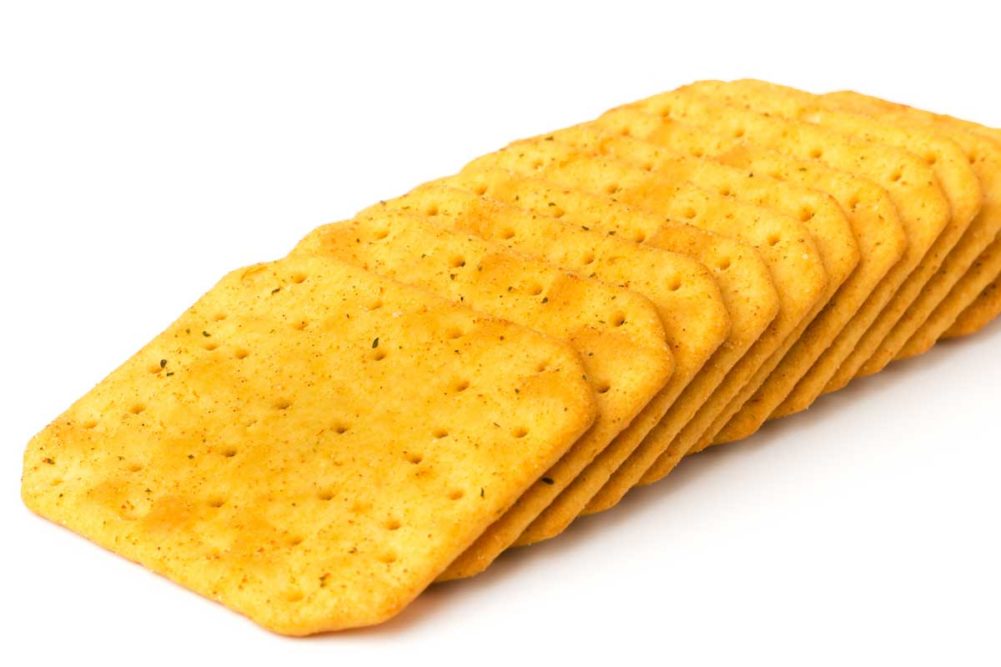Baking and cooling are challenging moments for strong, consistent crackers. Baking develops flavor, ensures structure and imparts the appropriate color. With such a thin product, it’s critical that moisture is removed consistently and evenly across the width of the oven so that every cracker is the same. This is all dependent on nailing the bake profile suitable to the product.
“It is important to use a typical ‘bell’ shape baking curve,” said Kevin Knott, technical sales manager, Bühler Group. “This means don’t try to rush the first phase of baking and then create a skin or shell on the product in the early stage of the baking.”
The bell shape baking curve of low heat, higher heat and then lower heat is followed for most cracker production lines, but it’s important that bakers understand if that works best for their products. For thin crisp crackers, that may not be the best fit, explained Ken Zvoncheck, director of process technology, Reading Bakery Systems (RBS).
“I may want to hit that cracker with a lot of heat in the beginning and then gradually reduce that temperature as it goes through the oven,” he said. “It’s product-specific, but applying the correct baking profile to that product is going to make the strongest cracker with the best integrity.”
[Related reading: Even, gentle sheeting critical for cracker strength]
Optimizing the bake profile is key to preventing checking, the bane of any cracker producer. An entire batch of crackers can pass quality assurance tests, be packaged and sit for 24 hours or even reach the consumer, only to fall a part due to unseen stress fractures.
“Checking is created by uneven moisture distribution, which causes stress gradient development,” explained David Hamilton, sales director, Spooner Vicars. “Stress gradient development is the rate of moisture migration from the biscuit core to the outer biscuit surface.”
Evenly removing that moisture in the oven or dryer keeps checking at bay, and the most straightforward way to achieve that is through the baking profile in the oven or dryer.
Historically, this has been done with direct-gas fired (DGF) ovens. These ovens deliver direct, intense heat that provides the Maillard reaction on the surface of the cracker and a natural, baked flavor. While this type of oven is still very effective at providing a well-baked cracker, convection ovens have provided efficient, even moisture removal in this application.

“More recently, hybrid oven technology has become more widespread,” Mr. Zvoncheck said. “Using both DGF and convection baking is both more efficient and more uniform than all DGF and allows the moisture to be baked out of the product more uniformly, thereby greatly reducing or eliminating checking.”
Many find the perfect bake in a hybrid oven that includes both types of heat transfer.
“A hybrid oven design with the final oven zone or zones being a direct-forced convection type of heat transfer will certainly ensure more consistent final product bake regarding even product moisture and color,” Mr. Hamilton explained.
Castellated plenum nozzles in Spooner Vicars’ hybrid ovens enables improved impingement air flow onto the product. This circulation helps move the product boundary moisture layer continuously. This movement, combined with the efficient moisture extraction, goes a long way to preventing checking from occurring.
In addition to hybrid heat technology, Bühler implements humidity sensor technology and steam injection to reduce checking and increase cracker strength.
[Related reading: Why high-speed cracker production requires a human touch]
“The injection of steam in the first zone rapidly raises the humidity in the bake chamber,” Mr. Knott said. “This then slows the rate of evaporation from the surface of the cracker, which, in turn, reduces the stress, or checking, and strengthens the final product.”
Post-bake dryers can also be used in conjunction with hybrid, DGF or convection ovens to help remove any remaining vestiges of moisture. By adding this final drying phase after the crackers are baked, operators can remove the last 4 to 5% of moisture from the crackers and eliminate checking, increase throughput and improve shelf life, according to Tim Clark, president and chief executive officer of Radio Frequency.
“As a baked product develops crumb structure and loses moisture content, it becomes less of a thermal conductor and a greater thermal insulator,” he explained. “Conventional drying decreases in efficiency at this point.”
In contrast, Radio Frequency’s radio frequency generator creates an alternating electric field between two electrodes above and below the conveyor. Because the water molecule responds to this field, Radio Frequency drying gets to the heart of the cracker, the last remnants of moisture in the interior, creating a uniform profile throughout. Because checking issues relate directly to a non-uniform moisture content, radio frequency post-bake drying can assist in eliminating this concern.
Integrity may seem like a pretentious word to place on a box of crackers, but it’s dough integrity that determines whether or not that box of crackers lives up to consumer expectations for whole, even, well-shaped crackers. Every step of production can either preserve and improve that integrity or weaken it, so it’s critical that bakers optimize their processes to keep delivering strong, consistent crackers.
This article is an excerpt from the November 2020 issue of Baking & Snack. To read the entire feature on cracker technology, click here.






